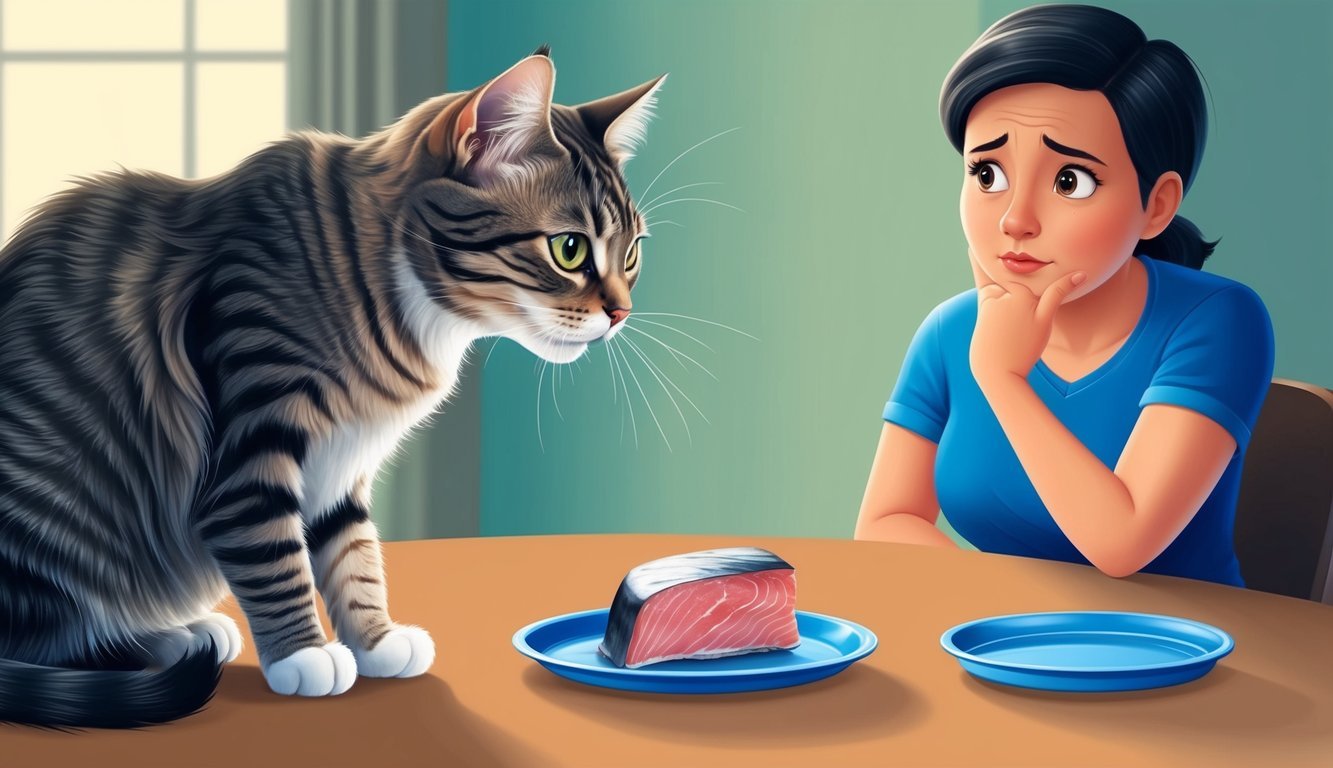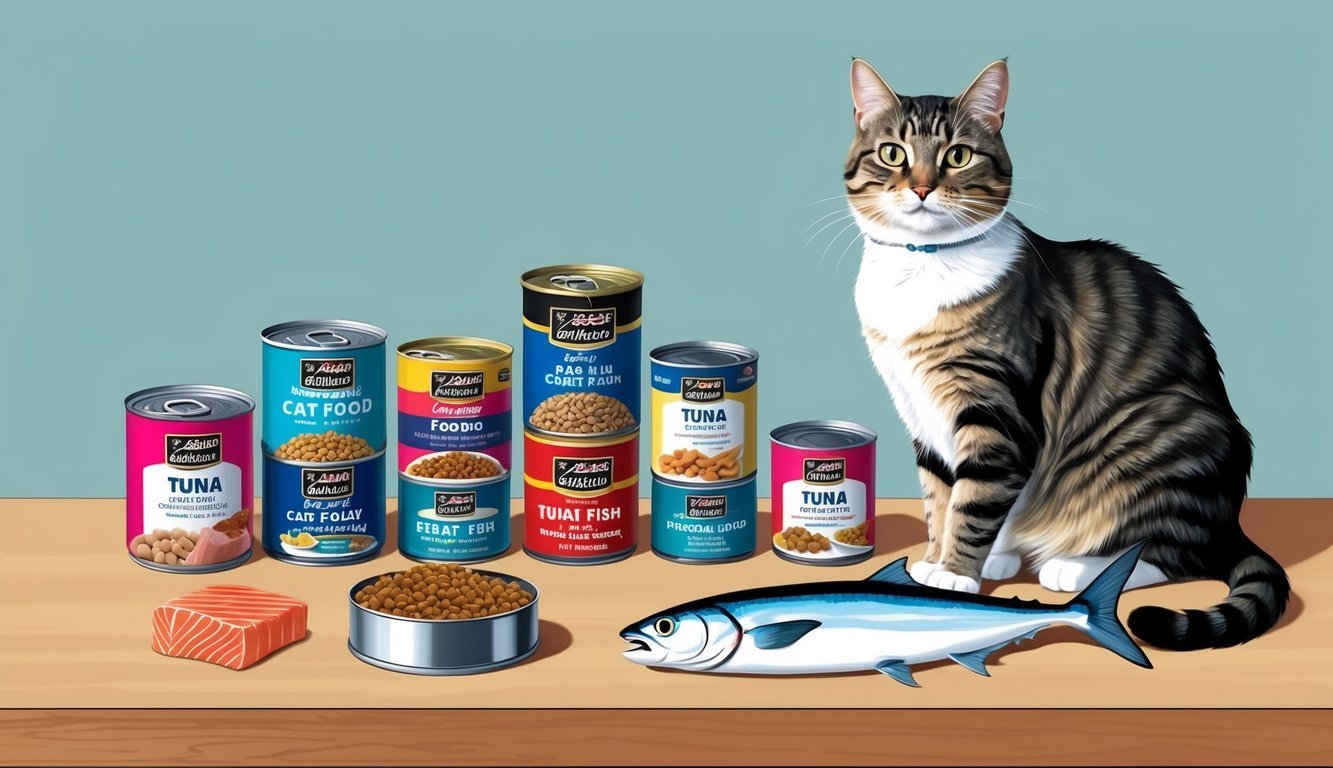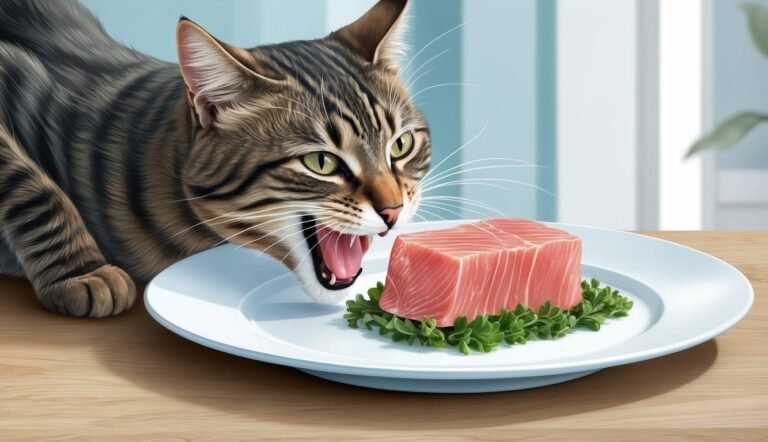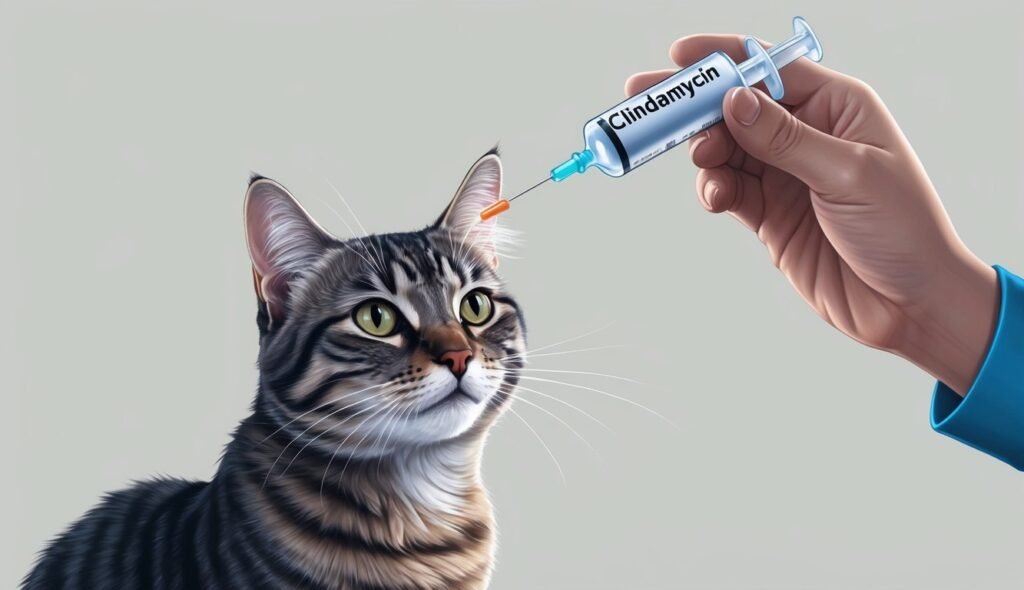When it comes to your feline friend, you might wonder if it’s safe to treat them with raw tuna.
Raw tuna is not suitable for cats due to bacteria and nutritional imbalances.
While cats can enjoy tuna as an occasional treat, it’s crucial to understand what types are safe and what you should avoid.
Cats are obligate carnivores, meaning their diets primarily rely on meat.
Although fish like tuna may seem appealing, feeding your cat raw tuna frequently can lead to serious health concerns, including mercury poisoning and deficiencies in essential nutrients.
If you’re considering adding fish to your cat’s meals, consulting with a veterinarian can help you navigate the best options for their health.
Understanding the risks and health implications ensures your furry companion enjoys their diet safely and nutritiously.
Key Takeaways
- Raw tuna can pose health risks for cats.
- Consult your vet before making dietary changes.
- Nutritional balance is key for your cat’s well-being.
Understanding Cat Nutrition
Cats have unique nutritional needs due to their nature as obligate carnivores.
It’s essential to provide them with a diet that meets these needs to ensure their overall health and well-being.
Here’s a closer look at what cat nutrition entails.
Obligative Carnivores and Their Diet
As obligate carnivores, cats require a diet primarily consisting of meat.
Their bodies are designed to derive most of their nutrients from animal sources.
Unlike humans or dogs, cats cannot thrive on a vegetarian diet.
Feline physiology shows that they lack the necessary enzymes to effectively process plant material.
This means you should prioritize high-quality protein sources in their diet.
Feeding your cat raw tuna occasionally might be tempting, but it doesn’t fulfill all their dietary requirements.
Stick to meat-based foods for a balanced approach.
Essential Nutrients for Cats
Cats need certain essential nutrients that are typically found in animal products.
These include:
- Protein: Crucial for muscle development and overall health.
- Taurine: An amino acid that’s vital for heart and eye health.
- Vitamins and Minerals: Important for various bodily functions. For example, Vitamin A and B vitamins from meat help support overall health.
Cats also need fats in their diet for energy and healthy skin.
Be mindful of the sources of these nutrients to ensure your cat is getting what they need.
Balanced Diet for Optimal Health
Offering a balanced diet is key to keeping your cat healthy.
This includes a mix of high-quality proteins, fats, carbohydrates, vitamins, and minerals.
Commercial cat foods are formulated to meet these nutritional needs, making them a reliable choice.
Look for options labeled “complete and balanced.”
When considering treats, such as raw tuna, limit portions to avoid imbalances.
Regular check-ups with a vet can also help you monitor your cat’s health and nutritional needs.
The Debate on Tuna for Cats

Tuna can be a tempting treat for your feline friend, but there are important considerations.
Understanding the appeal, potential benefits, and the role of tuna in your cat’s diet is essential for making informed choices.
The Appeal of Tuna to Cats
Cats are often drawn to tuna due to its strong aroma and rich flavor.
Being carnivores, they naturally seek out protein sources, and tuna fits the bill with its meaty texture.
Many cats view tuna as a delicacy, so it’s no surprise that pet owners might want to share this treat.
Additionally, the high-fat content in tuna can make it particularly appealing.
However, it’s important to recognize that while cats love it, not all tuna is created equal.
Fresh, raw fish can entice your pet, but certain types of tuna contain higher levels of mercury, which can be harmful.
Potential Benefits and Risks
Tuna does come with some benefits.
It serves as a valuable source of protein and can be a good treat when fed in moderation.
Cats may benefit from the amino acids and vitamins found in tuna, which can support their overall health.
On the downside, there are risks to consider.
Raw tuna may contain harmful pathogens that can upset your cat’s digestive system.
Additionally, the consumption of too much tuna can lead to nutrient imbalances.
Tuna should never dominate a cat’s diet, as it lacks some essential nutrients.
Tuna in a Cat’s Regular Diet
While some owners may wonder if they can regularly include tuna in their cat’s meals, it’s not advisable.
Tuna should not make up a significant part of your cat’s daily intake.
When considering the nutritional needs of your pet, a balanced diet formulated specifically for cats is crucial.
Many veterinarians recommend that tuna should account for no more than 10% of your cat’s total calorie intake.
Relying solely on tuna may lead to deficiencies in vital nutrients like taurine, which is critical for heart and eye health.
If you choose to give your cat tuna, opt for canned tuna in water, avoiding brine or oil, which can be unhealthy.
Always cook any fresh tuna thoroughly and avoid seasoning to keep it safe for your cat.
Risks of Feeding Cats Raw Tuna
Feeding your cat raw tuna may seem tempting, but it comes with several health risks.
It’s crucial to understand the potential dangers, including mercury exposure, nutrient absorption issues, and the risk of bacteria and parasites.
Mercury Exposure and Poisoning
Raw tuna can contain high levels of mercury, which can be harmful to your cat.
Cats that consume too much mercury may face various health issues.
Symptoms of Mercury Poisoning:
- Tremors
- Vision problems
- Behavioral changes
It’s essential to limit your cat’s exposure to fish with high mercury levels.
While tuna is a popular choice, consider offering other types of fish that have lower mercury concentrations.
Always consult your veterinarian for guidance on safe feeding practices.
Thiaminase and Nutrient Absorption
Raw tuna contains an enzyme called thiaminase, which can destroy vitamin B1 (thiamine).
Thiamine is vital for your cat’s energy metabolism and neurological function.
Consequences of Thiamine Deficiency:
- Loss of appetite
- Weakness
- Neurological issues
Cooking tuna eliminates thiaminase, making it a safer option.
If you do choose to feed your cat tuna, consider offering small amounts of cooked tuna instead of raw to protect their nutrient absorption and overall health.
Bacterial Contamination and Parasites
Feeding raw tuna to your cat poses a risk of bacterial contamination.
Raw fish may harbor bacteria like Salmonella or Listeria, which can lead to gastrointestinal issues.
Common Symptoms of Infection:
- Vomiting
- Diarrhea
- Fever
Parasites are another concern.
Raw fish can be a source of parasites that may harm your cat.
Properly cooking tuna helps eliminate these risks, making it a healthier choice.
Always prioritize your cat’s health by choosing safe feeding options.
Specific Health Concerns
When considering feeding your cat raw tuna, it’s essential to be aware of several specific health concerns that can arise.
These issues can affect your cat’s health in significant ways and should be taken seriously.
Steatitis and Unsaturated Fats
Steatitis, commonly known as yellow fat disease, occurs when a cat’s diet is unbalanced in essential nutrients, particularly unsaturated fats.
Raw tuna can contain excessive levels of unsaturated fats, which may lead to inflammation of the fat tissue.
If your cat consumes a diet high in raw tuna, there’s a risk of developing this condition.
Symptoms can include painful, swollen areas under the skin, and an unwillingness to move.
To avoid this, ensure a balanced diet with the right mix of protein and fats, and limit the amount of raw tuna given.
Allergies and Digestive Complications
Food allergies in cats can manifest with symptoms like vomiting, diarrhea, or skin irritations.
While it’s not common, some cats may develop allergies to fish, including tuna.
If you notice unusual reactions after feeding raw tuna, it might be time to consult your veterinarian.
Digestive issues can also arise from the high protein and fat content in raw tuna.
Cats may experience stomach upsets if their system isn’t used to digesting such rich foods.
Always introduce new treats in moderation to monitor any adverse effects on your cat’s digestion.
Heart and Kidney Disease Correlations
A diet high in tuna may contribute to heart and kidney diseases over time.
While cats need a protein-rich diet, excessive protein from raw tuna can put stress on these organs.
The increased levels of mercury found in some types of fish can also pose risks over the long term.
Observable symptoms of heart or kidney issues include increased thirst, lethargy, or difficulty breathing.
Regular veterinary check-ups are critical when feeding your cat foods like raw tuna.
Keeping an eye on your cat’s health will help ensure any issues are caught early on.
Recommended Feeding Practices
Feeding your cat tuna requires careful thought to ensure their health and safety.
It’s important to know suitable alternatives and establish guidelines for proper consumption.
Alternatives to Raw Tuna
If you’re considering options for your cat, canned tuna can be a safer choice than raw fish.
When selecting canned tuna, look for those packed in water rather than oil or brine to reduce sodium and digestive issues.
Canned tuna should be a treat, not a staple.
Balanced commercial cat foods are designed to meet all your cat’s nutritional needs.
You can also consider cooked chicken, which offers a familiar protein without the risks associated with raw fish.
Incorporating whole grains, like brown rice or oatmeal, and vegetables like pumpkin can add fiber and nutrients.
Guidelines for Tuna Consumption
The key is moderation.
A general recommendation is to limit tuna to about 1 tablespoon for a 10-pound cat.
This amounts to no more than 10% of their daily calorie intake.
Always cook tuna to human consumption standards and avoid adding any spices or oils.
If you opt for canned tuna, ensure it’s fish in water to keep things healthy.
Offer tuna as an occasional treat, perhaps once a week, rather than a daily meal.
Regularly assess your cat’s overall animal protein intake from their primary food source to maintain a balanced diet.
Consulting with Professionals
When considering whether to feed your cat raw tuna, it’s crucial to consult professionals.
Veterinarians can provide tailored advice about feline nutrition and any potential health concerns regarding raw fish.
The Role of Veterinarians in Feline Nutrition
Veterinarians play a vital role in ensuring your cat’s dietary needs are met.
They can help you understand the nutritional content of different foods, including raw tuna, and its impact on your cat’s health.
Key considerations include:
-
Health Concerns: Raw fish can harbor harmful bacteria that might upset your cat’s digestive system. Your vet can assess any health risks based on your cat’s individual health profile.
-
Diet Balance: Your vet can guide you on how much tuna to include in your cat’s diet. They will recommend that treats, like tuna, should only make up a small percentage of their overall food intake.
-
Commercial Alternatives: Many cat foods are formulated with the right balance of nutrients. Your veterinarian can recommend high-quality products that may include safe fish options without the risks associated with raw.
Engaging with a veterinarian ensures you make informed decisions about your cat’s diet, promoting long-term health and wellness.
Supplementary Nutrients for Cats

Your cat’s diet is essential for maintaining its overall health.
Certain nutrients play a significant role in promoting well-being and vitality.
Here are two key areas to consider for your feline friend.
Vitamin E and Thiamine
Vitamin E is an important antioxidant that supports your cat’s immune system and overall health.
It helps protect cells from damage caused by free radicals.
Cats need a sufficient amount of this vitamin to maintain healthy skin and to prevent issues like dryness and irritation.
Thiamine, also known as vitamin B1, is crucial for energy metabolism and nerve function.
A deficiency can lead to serious health issues, including neurological problems.
Canned tuna may lack adequate thiamine since the canning process removes thiaminase, which destroys this nutrient in raw fish.
You should ensure your cat’s diet is balanced to prevent any thiamine deficiency, especially if you’re incorporating tuna as an occasional treat.
Fatty Acids for Skin and Coat Health
Omega-3 fatty acids, particularly EPA and DHA, are vital for maintaining your cat’s skin and coat health.
These essential fats promote a shiny coat and can reduce inflammation, which is beneficial for cats with skin sensitivities.
Including sources of omega-3, like certain fish oils, can enhance your cat’s diet.
Be mindful of the balance, as too much fish could lead to excessive calorie intake.
It’s best to treat tuna as an occasional addition rather than a primary component of their meals to ensure optimal nutrient absorption without overexposure to any potential toxins.
Common Misconceptions

When it comes to cats and raw tuna, several myths persist that can influence your decisions as a pet owner.
Understanding these misconceptions is key to ensuring your cat’s diet is both safe and healthy.
Myths About Cats and Raw Fish Consumption
A common belief is that raw fish, including tuna, is a natural treat for cats.
While many cats are attracted to fish, raw tuna can pose risks.
It may carry harmful bacteria like Salmonella or E. coli, which can lead to serious health issues.
Another misconception involves the type of tuna.
While fresh tuna can be appealing, certain species, like albacore, contain higher mercury levels.
Long-term exposure to mercury can lead to toxicity, affecting your cat’s coordination and behavior.
Additionally, some people think raw fish helps prevent inflammatory conditions.
In reality, excessive amounts of raw tuna can lead to nutritional imbalances and potential health risks.
Always prioritize cooked or canned options in moderation to keep your feline friend safe and healthy.
Evaluating Commercial Cat Foods

Choosing the right commercial cat food is crucial for ensuring your cat’s nutritional needs are met.
Focusing on ingredients and their nutritional content helps you make informed decisions for your feline friend.
Assessing Ingredients and Nutritional Content
When evaluating commercial cat foods, start by reading the ingredient list.
Look for high-quality proteins, such as chicken or fish, listed as the first ingredient.
Avoid products with vague labels like “meat by-products,” as these can indicate lower quality.
Check for essential nutrients, including taurine, which is vital for heart and eye health.
It’s also beneficial if the food has omega fatty acids to support skin and coat health.
A good cat food should have a balanced ratio of protein, fat, and carbohydrates.
For example, aim for a protein content of 30-50% with minimal fillers like corn or wheat.
Always review feeding guidelines on the packaging to tailor portion sizes based on your cat’s age, weight, and activity level.
This ensures your cat receives the right amount of nutrients without overfeeding.
Frequently Asked Questions

When it comes to feeding your cat raw tuna, there are several important factors to consider.
Understanding the safety, risks, and differences between raw and canned tuna can help you make informed decisions for your feline friend.
Is it safe for my cat to eat raw fish, like tuna and salmon?
Generally, it’s not recommended to feed your cat raw fish, including tuna and salmon.
While some cats in the wild may consume raw fish, domestic cats are more vulnerable to bacteria and parasites present in raw seafood, which can lead to health issues.
What are the risks of feeding my cat raw tuna specifically?
Raw tuna poses specific risks due to the presence of harmful bacteria and parasites.
Additionally, tuna can contain thiaminase, an enzyme that destroys thiamine, a critical vitamin for your cat’s health.
A deficiency in thiamine can lead to neurological problems.
Can my cat have a little sushi as a treat, or is that not recommended?
While sushi might seem like a fun treat, it’s best to avoid giving your cat any sushi containing raw fish.
The risks associated with raw ingredients outweigh any potential enjoyment, especially since sushi often includes additives like soy sauce that are harmful to cats.
How much raw tuna is safe to give to my cat?
If you ever choose to give your cat raw tuna, limit it to very small amounts.
A bite-sized piece is sufficient.
Frequent feeding can lead to health issues due to the risks involved with raw fish consumption.
Are there differences between feeding cats canned tuna and raw tuna?
Yes, there are significant differences.
Canned tuna is generally safer because the canning process eliminates harmful bacteria and thiaminase.
When choosing canned tuna, opt for options in water rather than oil or brine, as these can be unhealthy for your cat.
Should I steer clear of giving my cat any raw seafood, including sashimi?
Yes, you should avoid all raw seafood, including sashimi.
The risks of bacteria, parasites, and harmful enzymes apply to all types of raw fish.
Prioritizing your cat’s health is essential, so sticking to cooked or canned options is the safer choice.



